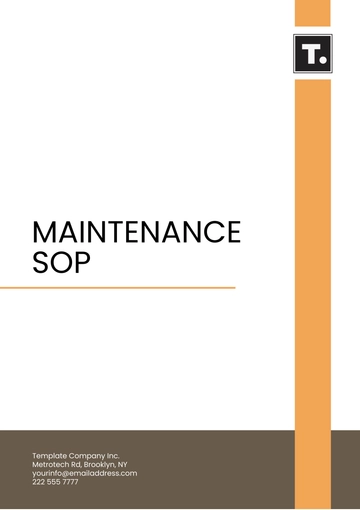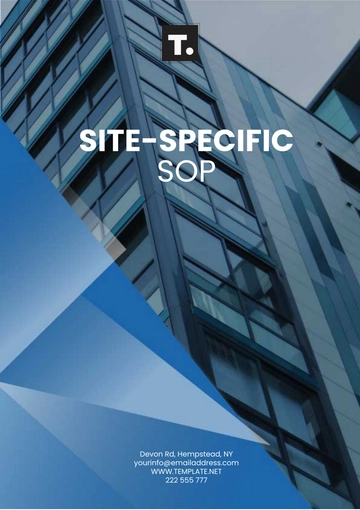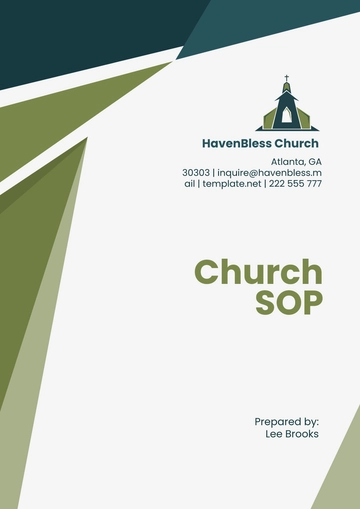Free Hotel Safety SOP

I. Introduction
A. Purpose
The purpose of this Safety Standard Operating Procedure (SOP) is to outline and implement a comprehensive safety program to ensure the well-being of all guests, employees, and property at [Your Company Name]. This SOP aims to provide clear guidelines and protocols to prevent accidents, manage emergencies, and comply with relevant safety regulations.
B. Scope
This SOP applies to all operations within [Your Company Name], covering all departments, employees, contractors, and visitors. It includes detailed procedures for managing fire safety, medical emergencies, natural disasters, security incidents, and general hazard prevention.
C. Policy Statement
[Your Company Name] is committed to maintaining a safe and secure environment. Our goal is to minimize risks through proactive measures, regular training, and strict adherence to safety protocols. Safety is a collective responsibility, and every member of the [Your Company Name] team is expected to contribute to creating a safe environment.
II. Roles and Responsibilities
A. General Manager
The General Manager holds overall responsibility for the implementation and effectiveness of safety policies and procedures. They ensure that all safety measures are integrated into daily operations and that resources are allocated to support safety initiatives.
B. Safety Officer
The Safety Officer is responsible for the day-to-day management of safety procedures. This includes conducting regular safety audits, identifying potential hazards, and ensuring compliance with safety regulations. The Safety Officer also organizes training sessions and safety drills, ensuring that all staff members are adequately prepared for emergencies.
C. Department Managers
Department Managers are accountable for enforcing safety protocols within their respective areas. They are responsible for training their teams on specific safety procedures relevant to their tasks. Additionally, they conduct routine safety checks and address any identified hazards promptly.
D. All Employees
Every employee at [Your Company Name] has a role in maintaining a safe environment. Employees must adhere to all safety protocols, participate in training sessions, and report any safety hazards or incidents to their supervisors immediately.
III. Safety Training and Awareness
A. Training Programs
[Your Company Name] provides comprehensive safety training programs to ensure that all employees understand their responsibilities and the procedures they must follow. New hires undergo an initial safety orientation that covers general safety policies, emergency procedures, and the use of personal protective equipment (PPE). Regular safety drills, including fire and earthquake drills, are conducted to keep all staff prepared for emergencies. Specialized training is provided for handling hazardous materials and operating specific equipment safely.
B. Safety Meetings
Monthly safety meetings are held to review any safety incidents, discuss updates to safety protocols, and address any concerns raised by staff. These meetings provide a platform for continuous improvement and ensure that safety remains a priority for everyone at [Your Company Name].
C. Signage and Communication
Clear and effective safety signage is strategically placed throughout the hotel to guide staff and guests in the event of an emergency. Communication channels, including a dedicated safety hotline and email address, are available for reporting hazards and seeking advice on safety-related issues.
IV. Emergency Procedures
A. Fire Safety
[Your Company Name] has established detailed fire safety procedures to protect guests and staff in the event of a fire.
Evacuation Plans and Routes:
Each floor of the hotel has clearly marked evacuation routes, and all exits are well-lit and free of obstructions. Employees are trained to assist guests during evacuations and ensure that everyone reaches the designated assembly points safely. Regular fire drills are conducted to familiarize staff and guests with the evacuation process.
Fire Extinguisher Locations and Usage:
Fire extinguishers are strategically placed throughout the hotel, including in corridors, kitchens, and storage areas. Employees receive training on the proper use of fire extinguishers, including the PASS (Pull, Aim, Squeeze, Sweep) technique. Regular checks are performed to ensure that all fire extinguishers are in working order and easily accessible.
Fire Alarm Testing and Maintenance:
The hotel's fire alarm system is tested monthly to ensure it is functioning correctly. Maintenance staff are responsible for inspecting smoke detectors, sprinkler systems, and other fire safety equipment. Any issues identified during these inspections are addressed immediately to maintain a high level of fire safety readiness.
B. Medical Emergencies
First Aid Kits and AED Locations:
First aid kits are available at key locations throughout the hotel, including the front desk, housekeeping areas, and maintenance rooms. Each kit is stocked with essential supplies such as bandages, antiseptics, and pain relievers. Automated External Defibrillators (AEDs) are also available and are regularly checked to ensure they are in working condition. Employees receive training on how to use first aid kits and AEDs effectively.
Procedures for Medical Emergencies:
In the event of a medical emergency, employees are instructed to call emergency services immediately and provide first aid until professional help arrives. Detailed procedures are in place for managing common medical emergencies, including heart attacks, choking, and injuries. Staff are trained to remain calm, provide reassurance to the patient, and follow the established protocols to ensure the best possible outcome.
C. Natural Disasters
Procedures for Earthquakes, Floods, and Other Natural Disasters:
[Your Company Name] has developed comprehensive procedures to protect guests and staff during natural disasters. These procedures include designated safe zones within the hotel where guests and employees can take shelter. For earthquakes, staff are trained to guide guests to these safe zones and ensure that everyone stays away from windows and heavy objects. In the event of a flood, the hotel has protocols for moving guests to higher floors and securing vital equipment.
Safe Zones and Shelter-in-Place Protocols:
Safe zones are clearly marked, and employees are familiar with their locations. Shelter-in-place protocols include instructions for remaining indoors, securing the premises, and maintaining communication with local authorities. Regular drills are conducted to ensure that all staff members understand their roles and responsibilities during a natural disaster.
D. Security Incidents
Handling of Theft, Assault, and Other Security Threats:
Security incidents such as theft, assault, and other threats are managed through a combination of preventive measures and responsive protocols. Surveillance cameras are installed in key areas to deter criminal activity and assist in investigations. Employees are trained to recognize suspicious behavior and report it to the Security Officer immediately.
Coordination with Local Law Enforcement:
[Your Company Name] maintains a strong relationship with local law enforcement agencies. In the event of a serious security incident, employees are instructed to contact law enforcement promptly. The hotel's Security Officer coordinates with the authorities, providing them with necessary information and supporting their efforts to resolve the situation.
V. Hazard Identification and Risk Assessment
A. Routine Inspections
Regular safety inspections are conducted to identify and address potential hazards within the hotel. These inspections cover all areas of the property, including guest rooms, public spaces, kitchens, and maintenance areas. The Safety Officer is responsible for organizing these inspections and ensuring that any identified hazards are addressed promptly.
Inspection Schedule:
Area | Frequency | Responsible Person |
|---|---|---|
Guest Rooms | Weekly | Housekeeping Manager |
Public Spaces | Bi-weekly | Safety Officer |
Kitchens | Daily | Executive Chef |
Maintenance Areas | Monthly | Maintenance Manager |
B. Risk Assessment
The Safety Officer conducts regular risk assessments to identify potential hazards and assess their impact on guests and staff. These assessments involve evaluating the likelihood of incidents occurring and the potential severity of their consequences. Based on the findings, corrective actions are implemented to mitigate risks and enhance safety.
C. Corrective Actions
Corrective actions may include physical modifications to the property, such as installing additional safety equipment or improving lighting in dark areas. Procedural changes, such as updating safety protocols or enhancing staff training, are also implemented to address identified risks. The effectiveness of these actions is monitored, and adjustments are made as necessary.
VI. Maintenance and Housekeeping
A. Regular Maintenance
Ensuring that all equipment and facilities are in safe working order is a key component of [Your Company Name]'s safety program. The Maintenance Department is responsible for conducting regular checks and performing necessary repairs to maintain the safety and functionality of the hotel's infrastructure.
Maintenance Schedule:
Equipment | Frequency | Responsible Person |
|---|---|---|
HVAC Systems | Quarterly | Maintenance Manager |
Elevators | Monthly | Maintenance Manager |
Fire Safety Systems | Monthly | Safety Officer |
Kitchen Equipment | Weekly | Executive Chef |
B. Housekeeping Protocols
Housekeeping staff play a critical role in maintaining a safe environment for guests and employees. Proper handling and storage of cleaning chemicals are essential to prevent accidents and health hazards. Housekeeping staff are trained to follow safety data sheets (SDS) for all chemicals used and to store them in designated areas away from guest access.
C. Safe Handling and Storage of Cleaning Chemicals
Chemicals are stored in labeled containers, and housekeeping staff use appropriate PPE, such as gloves and masks, when handling them. Regular audits are conducted to ensure compliance with safety protocols and to identify any potential issues that need to be addressed.
D. Procedures for Reporting and Addressing Safety Hazards
Housekeeping staff are encouraged to report any safety hazards they encounter during their duties. A reporting system is in place to document these hazards and track the actions taken to resolve them. Immediate hazards are addressed promptly, while less urgent issues are scheduled for resolution as part of regular maintenance activities.
VII. Health and Safety Regulations Compliance
A. Legal Requirements
Compliance with local, state, and federal health and safety regulations is crucial for [Your Company Name]. The Safety Officer is responsible for ensuring that all operations meet regulatory standards. This includes maintaining proper documentation, conducting regular audits, and implementing corrective actions when necessary.
B. Documentation and Record-Keeping
Accurate records of safety inspections, incidents, and training are essential for demonstrating compliance and identifying areas for improvement. [Your Company Name] maintains detailed logs of all safety activities, ensuring that records are readily accessible for review by regulatory authorities.
Compliance Checklist:
Activity | Frequency | Responsible Person |
|---|---|---|
Safety Inspections | Monthly | Safety Officer |
Employee Safety Training | Quarterly | Training Manager |
Fire Alarm System Testing | Monthly | Maintenance Manager |
Hazardous Material Handling | Ongoing | Housekeeping Manager |
VIII. Incident Reporting and Investigation
A. Reporting Procedures
Timely and accurate reporting of accidents, injuries, and safety hazards is essential for maintaining a safe environment. [Your Company Name] has established a clear procedure for reporting incidents. Employees are instructed to report incidents to their immediate supervisor, who will then document the details and notify the Safety Officer.
B. Investigation Protocols
The Safety Officer conducts thorough investigations of all reported incidents to determine the root cause and implement preventive measures. This process includes interviewing witnesses, reviewing surveillance footage, and analyzing any physical evidence. The findings are documented, and corrective actions are tracked to ensure they are completed.
IX. Personal Protective Equipment (PPE)
A. PPE Requirements
The use of personal protective equipment (PPE) is mandatory for tasks that present potential hazards. [Your Company Name] provides all necessary PPE, including gloves, masks, safety goggles, and aprons. Employees are trained on the proper use, maintenance, and disposal of PPE to ensure their safety.
PPE Inventory:
PPE Item | Quantity | Location | Responsible Person |
|---|---|---|---|
Gloves | 200 pairs | Housekeeping Dept | Housekeeping Manager |
Masks | 150 units | Front Desk | Front Desk Manager |
Safety Goggles | 50 units | Maintenance Room | Maintenance Manager |
Aprons | 75 units | Kitchen | Executive Chef |
B. Proper Usage and Maintenance of PPE
Employees are instructed to inspect PPE before use, replace damaged equipment immediately, and follow hygiene protocols for reusable items. Regular training sessions reinforce the importance of PPE in preventing injuries and ensuring compliance with safety regulations.
X. Guest Safety
A. Guest Information
Ensuring the safety of guests is a top priority for [Your Company Name]. Information about safety procedures, including emergency exits and assembly points, is provided to guests upon check-in. This information is also available in guest rooms and common areas.
B. Safety Measures
Guest areas are regularly inspected to identify and address potential hazards. This includes ensuring that walkways are clear, lighting is adequate, and emergency exits are accessible. Staff are trained to assist guests during emergencies and provide clear instructions on evacuation procedures.
Emergency Information for Guests:
Safety Information | Location |
|---|---|
Evacuation Routes | Back of Room Door |
Assembly Points | Lobby, Meeting Rooms |
Emergency Contact Numbers | Guest Directory |
First Aid Kit Locations | Reception, Lobby |
C. Providing Secure Storage for Guest Valuables
Secure storage options, such as in-room safes and safety deposit boxes at the front desk, are available for guests to store their valuables. Guests are advised to use these facilities and not leave valuable items unattended in public areas.
XI. Continuous Improvement
A. Feedback and Review
Feedback from staff and guests is invaluable for improving safety protocols. [Your Company Name] encourages open communication and regularly seeks feedback on safety issues. This feedback is reviewed during monthly safety meetings, and necessary adjustments are made to enhance safety measures.
B. SOP Updates
The Safety Officer is responsible for reviewing and updating the SOP regularly to ensure it reflects current best practices and regulatory requirements. Any changes are communicated to all employees, and additional training is provided if necessary.
Review and Feedback Schedule:
Activity | Frequency | Responsible Person |
|---|---|---|
Safety SOP Review | Quarterly | Safety Officer |
Staff Feedback Collection | Monthly | HR Manager |
Guest Feedback Collection | Ongoing | Front Desk Manager |
XII. Conclusion
The safety of guests and employees at [Your Company Name] is of utmost importance. This SOP provides a comprehensive framework for maintaining a safe environment through proactive measures, regular training, and strict adherence to established protocols. The commitment to safety is reflected in every aspect of hotel operations, from routine maintenance to emergency preparedness, creating a welcoming and protected space for everyone.
For any questions or concerns regarding safety procedures, please contact the Safety Officer at:
Name: [Safety Officer's Name]
Email: [Your Company Email]
Phone: [Your Company Number]
By following these detailed safety procedures, [Your Company Name] ensures that all guests and employees can enjoy a safe and secure environment, fostering trust and confidence in the hotel's commitment to their well-being.
- 100% Customizable, free editor
- Access 1 Million+ Templates, photo’s & graphics
- Download or share as a template
- Click and replace photos, graphics, text, backgrounds
- Resize, crop, AI write & more
- Access advanced editor
Standardize procedures with Template.net's Hotel Safety SOP Template. This customizable and editable template, accessible through the Ai Editor Tool, helps you develop detailed safety standard operating procedures. Personalize it to include specific safety protocols. Ensure clear and consistent guidelines to maintain high safety standards and ensure compliance within your hotel.





























